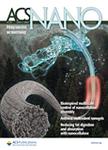版权所有:内蒙古大学图书馆 技术提供:维普资讯• 智图
内蒙古自治区呼和浩特市赛罕区大学西街235号 邮编: 010021

作者机构:Natl Inst Chem Dept Mat Chem Ljubljana 1000 Slovenia Univ Ljubljana Fac Chem & Chem Technol Ljubljana 1000 Slovenia Univ Nova Gorica Nova Gorica 5000 Slovenia
出 版 物:《ACS NANO》 (ACS Nano)
年 卷 期:2025年第19卷第2期
页 面:2334-2344页
核心收录:
学科分类:07[理学] 070203[理学-原子与分子物理] 0805[工学-材料科学与工程(可授工学、理学学位)] 0703[理学-化学] 0702[理学-物理学]
基 金:H2020 European Research Council [P2-0393, I0-0003, J2-3041, N2-0257, J7-4637, GC-0001] Slovenian Research and Innovation Agency (ARIS) [123STABLE, 852208] European Research Council (ERC) Milan Lenarcic foundation
主 题:4D-STEM electrocatalysis IL-TEM alloy ordering unsupervised algorithms structure-stabilityrelationship platinum alloy
摘 要:Nanoparticulate electrocatalysts for the oxygen reduction reaction are structurally diverse materials. Scanning transmission electron microscopy (STEM) has long been the go-to tool to obtain high-quality information about their nanoscale structure. More recently, its four-dimensional modality has emerged as a tool for a comprehensive crystal structure analysis using large data sets of diffraction patterns. In this study, we track the alternations of the crystal structure of individual carbon-supported PtCu3 nanoparticles before and after fuel cell-relevant activation treatment, consisting of a mild acid-washing protocol and potential cycling, essential for forming an active catalyst. To take full advantage of the rich, identical location 4D-STEM capabilities, unsupervised algorithms were used for the complex data analysis, starting with k-means clustering followed by non-negative matrix factorization, to find commonly occurring signals within specific nanoparticle data. The study revealed domains with (partially) ordered alloy structures, twin boundaries, and local amorphization. After activation, specific nanoparticle surface sites exhibited a loss of crystallinity which can be correlated to the simultaneous local scarcity of the ordered alloy phase, confirming the enhanced stability of the ordered alloy during potential cycling activation conditions. With the capabilities of our in-house developed identical-location 4D-STEM approach to track changes in individual nanoparticles, combined with advanced data analysis, we determine how activation treatment affects the electrocatalysts local crystal structure. Such an approach provides considerably richer insights and is much more sensitive to minor changes than traditional STEM imaging. This workflow requires little manual input, has a reasonable computational complexity, and is transferrable to other functional nanomaterials.